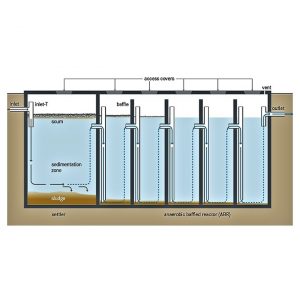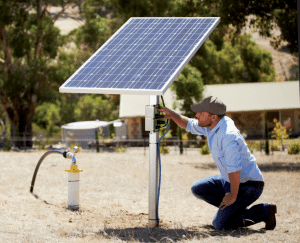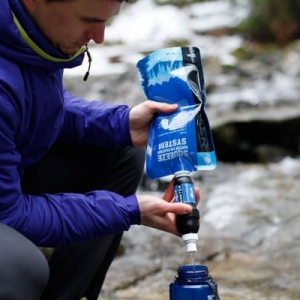
Agriculture
August 15, 2024
AnoxKaldnes Moving Bed Biofilm Reactor
Read SolutionImplemented by
AnoxKaldnes

Updated on January 12, 2024
·Created on September 30, 2018
Membrane Biofilm Reactors (MBR) are wastewater treatment systems which combine the membrane process of microfiltration with biological activated sludge process.
Membrane Biofilm Reactors (MBR) are wastewater treatment systems that combine a semi-permeable membrane with biological treatment processes. The membrane enables microfiltration while a suspended growth bioreactor enables biological decomposition. This type of wastewater treatment is commonly used by municipalities and industrial treatment.
The costs of MBR are dependant on the size of the system.
Target SDGs
SDG 6: Clean Water and Sanitation
Target Users (Target Impact Group)
Small and Medium-sized Enterprises, Public Sector Agencies
Distributors / Implementing Organizations
The MBR has been implemented by Weise Water GmbH, Fluence, Martin Membrane Systems, Triqua International bv and Ovivo.
Competitive Landscape
Direct competitors include AnoxKaldnes Moving Bed Biofilm Reactor and Sequential Batch Reactor.
Regions
Worldwide
Manufacturing/Building Method
MBRs are constructed by the manufacturer. For larger wastewater treatment plants, MBRs are build to bespoke specifications based on site specifications.
Intellectural Property Type
Open-source
User Provision Model
Users can obtain MBR directly from local manufacturers.
Distributions to Date Status
Due to the open source nature of the product, an exact distribution to date is unknown.
Flow rate (L/min)
Flow rate dependant on site specifications. <27.77 L/min for small containerised plants and 1527-13,194 L/min for municipal plants.
Power Supply Type
Electrical
Technology type
Membrane, microfiltration, biological activated sludge process
BOD Removal Efficiency
98-99%
COD removal efficiency
99%
NH4-N Removal Efficiency
99%
TSS removal efficiency
99.9%
Total Phosphorus Removal Efficiency
97%
Fecal Coliform Removal Efficiency
90%
Design Specifications
The membranes in MBR are designed to have pores between 0.035 - 0.4 microns, depending on the desired level of filtration. The membrane type (including hollow fiber, spiral-wound, plat-and-frame, pleated filter cartridge, and tubular) is chosen by designers for application-specific designs. This scale of membranes eliminates the need for sedimentation, allowing the biological processes to operate at higher concentrations.
Technical Support
The complexity of the MBR system design requires that operators are technically trained. Training can be provided by the manufacturers.
Replacement Components
Replacement components are available directly from manufacturers.
Lifecycle
10 years
Manufacturer Specified Performance Parameters
Manufacturers specify performance targets related to eliminating the need for secondary filtration, reducing the plant footprint, prolonging sludge age (and therefore lowering sludge production), producing high quality effluent, and allowing for high loading rates.
Vetted Performance Status
Testing by the Lulea University of Technology to determine MBRs are viable for onsite wastewater treatment systems due to MBRs efficient COD (90 %) and Nitrogen (99 %) removal. Additional treatment is required for phosphorus removal to meet water quality regulations.
Safety
To reduce health risks, sludge should be dried and incinerated. The ashes can be stored in a landfill to prevent human contact.
Complementary Technical Systems
Cleaning systems must be used to maintain the membranes in MBR. Often the cleaning is performed using chemical mixtures to defoul the membranes.
Academic Research and References
Ueda, T., et al., 1997, “Effects of aeration on suction pressure in a submerged membrane bioreactor”, Water Research, 31: 489-494.
Larsson, E. and Persson, J., 2004, “Viability of Membrane Bioreactor Technology as an Advanced Pre-treatment for Onsite Wastewater Treatment“, Masters dissertation, Luleå University of Technology, Luleå, Sweden
Clara, M. et. al., 2005, “Removal of selected pharmaceuticals, fragrances and endocrine disrupting compounds in a membrane bioreactor and conventional wastewater treatment plants“, Water Research 39: 4797-4807.
Judd, S., 2008, “The status of membrane bioreactor technology“, Trends in Biotechnology 26: 109-116.
Achill, A., et al., 2009, “The forward osmosis membrane bioreactor: A low fouling alternative to MBR process”, Desalination 239: 10-21.
Aybar, M. et al., 2012, The Air-based Membrane Biofilm Reactor (MBfR) For Energy Efficient Wastewater Treatment, Proceedings of the Water Environment Federation 2012(10): 5458-5485
Kraume, M. et al., 2005, Nutrients removal in MBRs for municipal wastewater treatment, Water Sci. Technol. 51(6-7): 391-402
Lo, C.H., McAdam, E., Judd, S., 2015, The cost of a small membrane bioreactor, Water Science and Technology 72(10): 1739-1746
Compliance with regulations
The use of MBRs can aid wastewater treatment sites comply with country water quality discharge standards.
Evaluation methods
Each MBR is visually evaluated weekly to determine the extent to which fouling has clogged the membrane; when filtration has decreased, the membrane must be cleaned before operation continues.
Other Information
SSWM Factsheet - Membrane Bioreactor

Agriculture
August 15, 2024
Implemented by
AnoxKaldnes

Agriculture
August 8, 2024
Implemented by
Cranfield University

Agriculture
August 15, 2024
Implemented by
EAWAG

Agriculture
January 11, 2024

Agriculture
August 16, 2024

Agriculture
December 29, 2023
Implemented by
LifeStraw

Agriculture
December 27, 2023
Implemented by
Mono Pumps

Agriculture
October 14, 2023
Implemented by
P&G

Agriculture
August 17, 2024
Implemented by
Peepoople Kenya

Agriculture
December 29, 2023
Implemented by
Sawyer
Have thoughts on how we can improve?
Give Us Feedback